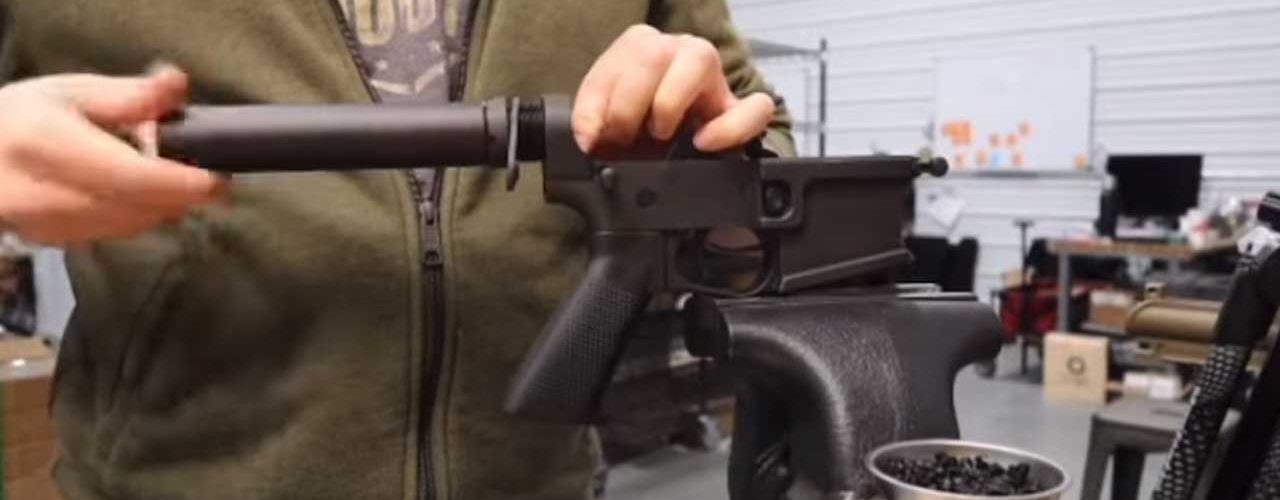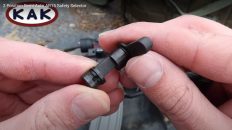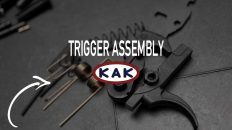When it comes to firearms, understanding the function and importance of each component is crucial for both safety and optimal performance. For a complete overview of the essential components in an AR-15, refer to our detailed guide on AR-15 components.
One such component that plays a significant role is the buffer tube. But what exactly does a buffer tube do, and why is it so important?
A buffer tube is an integral part of the firearm’s recoil management system. It helps to absorb and distribute the recoil energy generated when a firearm is fired, reducing felt recoil and controlling muzzle rise. This not only improves the overall shooting experience but also enhances accuracy by allowing for faster follow-up shots.
The buffer tube, attached to the lower receiver, also serves as the housing for the recoil spring and buffer. These components work together to provide smooth cycling of the firearm’s action, ensuring reliable feeding, chambering, and extraction of cartridges.
Understanding the function and importance of buffer tubes is essential for firearm enthusiasts, gunsmiths, and anyone interested in firearm mechanics. By comprehending how this component works, individuals can make informed decisions about their firearms, accessories, and modifications.
In this article, we will dive deeper into the function and importance of buffer tubes in firearms, providing valuable insights into their role in recoil management and overall firearm operation. Stay tuned to enhance your knowledge by exploring our firearms glossary to better understand this crucial firearm component.
The Role of Buffer Tubes in Firearm Function
Buffer tubes play a vital role in the overall function of firearms, particularly in modern semi-automatic and automatic rifles. Their primary purpose is to house the recoil spring and buffer, which work together to absorb and dissipate the energy produced when a firearm is discharged. This process is essential for managing recoil. When a bullet is fired, the energy generated can cause the firearm to jump and shift, making it difficult for the shooter to maintain aim. The buffer tube acts as a cylindrical frame that contains these components, allowing for a smoother cycling of the action.
The mechanics behind the buffer tube are relatively simple but highly effective. When the rifle is fired, the bolt carrier group moves rearward, compressing the recoil spring housed within the buffer tube. This spring then pushes the bolt carrier group forward after it has completed its cycle, chambering another round. The buffer itself acts as a cushion, providing additional resistance and helping to reduce the impact felt by the shooter. This system not only enhances the shooting experience but also increases the reliability of the firearm, as it ensures that the action cycles correctly without causing jams or misfires.
Moreover, the design of the buffer tube can also influence the firearm’s accuracy. A well-functioning buffer tube system helps maintain the alignment of the rifle during rapid fire, allowing the shooter to get back on target more quickly. This is particularly beneficial in competitive shooting scenarios or tactical situations where follow-up shots are crucial. In this sense, the buffer tube serves not just a mechanical function but also contributes to the overall performance and effectiveness of the firearm.
Different Types of Buffer Tubes
Buffer tubes come in a variety of types, each designed for specific applications and user preferences. The most common type is the standard buffer tube, often found on AR-15-style rifles. These tubes are typically made to accept adjustable stocks, allowing users to customize the length of pull to suit their shooting style. Adjustable buffer tubes offer the added benefit of accommodating different shooter sizes and body types, enhancing comfort and control.
Another variant is the carbine buffer tube, which is shorter than the standard buffer tube. This design is intended for compact rifles or pistols, where space savings are essential. Carbine buffer tubes often work in conjunction with specialized buffers and springs to optimize the cycling action, ensuring reliable operation even in a shorter format. This is particularly useful for individuals who prefer a lightweight and maneuverable firearm for personal defense or tactical applications.
Lastly, there are specialized buffer tubes designed for specific firearms or purposes. For example, some tactical shotguns utilize unique buffer tube designs to improve recoil management and overall handling. Additionally, there are buffer tubes designed for competition shooting, which may offer features such as enhanced weight distribution for improved stability. Understanding these variations allows firearm enthusiasts to choose the right buffer tube for their specific needs, thereby improving both comfort and functionality.
Buffer Tube Materials and Construction
The construction and materials used in buffer tubes are critical to their performance and longevity. Most buffer tubes are made from high-strength aluminum or steel, materials that can withstand the repeated stress and strain of firing. Aluminum buffer tubes are lightweight and resistant to corrosion, making them a popular choice for many modern firearms. On the other hand, steel buffer tubes tend to be more robust and can handle greater wear over time, although they may add some additional weight to the firearm.
The manufacturing process also plays a significant role in the quality of buffer tubes. Precision machining and high-quality finishes are essential to ensure that the tube is free from defects and fits properly with other components. Poorly manufactured buffer tubes can lead to misalignment issues, which may affect the cycling of the action and overall reliability of the firearm. Therefore, investing in a high-quality buffer tube is crucial for ensuring the long-term performance of a firearm.
Additionally, some manufacturers offer buffer tubes with advanced coatings or treatments to enhance durability and reduce friction. These coatings can help to minimize wear on both the buffer tube and the internal components, leading to smoother operation and prolonged service life. As enthusiasts seek to optimize their firearms for performance and reliability, understanding the materials and construction of buffer tubes becomes increasingly important.
Importance of Buffer Tubes in Firearm Safety
Firearm safety is paramount, and the buffer tube plays a significant role in ensuring the safe operation of modern firearms. A properly functioning buffer tube system helps to mitigate the dangerous effects of recoil, reducing the risk of accidental discharges due to a shooter flinching or losing control during firing. By managing recoil effectively, buffer tubes contribute to safer handling and operation of firearms, particularly during rapid-fire situations.
Moreover, buffer tubes also serve as structural components that house the recoil spring and buffer. These parts work in unison to prevent excessive movement of the bolt carrier group, which is essential for maintaining the firearm’s integrity. If a buffer tube were to fail or malfunction, it could lead to catastrophic failures, including the potential for the bolt carrier group to come out of alignment and cause serious damage to the firearm or injury to the shooter.
In addition to mechanical safety, buffer tubes also contribute to the overall ergonomics of the firearm. A well-designed buffer tube allows for better stock alignment and shooter comfort, which is crucial for maintaining control and accuracy. By enhancing the shooter’s ability to maintain a steady aim, buffer tubes indirectly support safe shooting practices. For these reasons, understanding the importance of buffer tubes in firearm safety is essential for both novice and experienced gun owners.
Buffer Tube Compatibility with Different Firearms
When it comes to firearms, not all buffer tubes are created equal. Compatibility is a crucial consideration for enthusiasts looking to upgrade or customize their firearms. Many modern rifles, particularly AR-15s and AR-10s, utilize buffer tubes that conform to specific industry standards. This standardization allows for a wide range of aftermarket stocks, grips, and other accessories to be easily installed, giving shooters the flexibility to tailor their firearms to their preferences.
However, not all firearms use buffer tubes in the same way. For instance, some tactical shotguns and pistols may have proprietary buffer tube designs that do not interchange with standard AR-style tubes. This lack of compatibility can limit customization options and may require shooters to seek out specific components that are designed to work with their particular firearm. Understanding these compatibility issues is essential for anyone considering modifications, as using the wrong buffer tube can lead to functional problems or even safety hazards.
Additionally, some firearms manufacturers produce proprietary buffer tubes that are optimized for their specific designs. These tubes may offer enhanced performance features, such as weight distribution or recoil mitigation, which can be beneficial for certain applications. Shooters should always consult their firearm’s manufacturer specifications to ensure that they are selecting the correct buffer tube, as using incompatible components can negatively impact both performance and safety.
Buffer Tube Accessories and Attachments
Buffer tubes are not just functional components; they also serve as a foundation for various accessories and attachments that can enhance the shooter’s experience. One of the most common accessories is the adjustable stock. These stocks allow shooters to modify the length of pull, thereby improving comfort and control during shooting. This is particularly important in tactical or competitive scenarios where quick adjustments may be necessary.
In addition to adjustable stocks, there are other accessories designed to improve the functionality of buffer tubes. For example, some manufacturers offer cheek risers, which elevate the shooter’s cheek weld for a better line of sight when aiming. These can be particularly useful for shooters using optics, as they help to achieve a more comfortable shooting position. Other attachments might include sling mounts or quick-release mechanisms that allow for rapid transitions between carrying modes.
Furthermore, some enthusiasts opt for specialized buffers or springs to be used in conjunction with their buffer tubes. These components can further enhance the cycling action, reduce felt recoil, or optimize the firearm for specific ammunition types. By understanding the range of accessories available for buffer tubes, shooters can significantly improve their firearms’ performance and tailor them to their individual shooting styles.
Buffer Tube Maintenance and Care
Proper maintenance and care of buffer tubes are essential for ensuring the longevity and functionality of firearms. Regular inspection is crucial to identify signs of wear or damage. A thorough check should include looking for any scratches, dents, or corrosion on the surface of the buffer tube. These issues can impede the smooth operation of the buffer spring and other internal components, leading to potential malfunctions.
Cleaning the buffer tube should also be part of a comprehensive firearm maintenance routine. Debris, dirt, and oil buildup can accumulate over time, affecting the cycling mechanism. Using a soft cloth and appropriate cleaning solvents can help to keep the buffer tube and its components in optimal condition. Additionally, lubricating the buffer spring and other moving parts can enhance functionality, ensuring smooth operation during firing.
Finally, understanding when to replace components is crucial for maintaining a firearm’s performance. Buffer tubes can wear out over time, especially under heavy use. If a buffer tube shows significant signs of wear or if the action becomes unreliable, it may be time to replace it. Using high-quality replacement parts can prevent issues down the line and ensure that the firearm remains safe and reliable. Regular maintenance not only improves performance but also enhances the overall safety of the firearm.
Common Misconceptions About Buffer Tubes
Buffer tubes are often surrounded by various misconceptions that can lead to misunderstandings about their function and importance. One common misconception is that buffer tubes are merely cosmetic components. In reality, they play a critical role in recoil management and the overall cycling of the firearm. Ignoring the importance of a quality buffer tube can lead to performance issues and even safety concerns.
Another frequent misunderstanding is that all buffer tubes are interchangeable. While many buffer tubes adhere to industry standards, there are numerous proprietary designs that may not fit with other brands or models. This can lead to compatibility issues and potentially dangerous situations if the wrong buffer tube is used. Shooters must do their research and ensure that any modifications or replacements are compatible with their specific firearm.
Lastly, some believe that upgrading to a more advanced buffer tube will automatically enhance the firearm’s performance. While high-quality buffer tubes can improve function, they must still be paired with appropriate components, such as the right buffer weight and spring. Simply swapping out a buffer tube without considering the entire system may not yield the expected results. Understanding these misconceptions can help shooters make informed decisions about their firearms, leading to better performance and safety.
Conclusion: The Significance of Buffer Tubes in Firearm Performance
In summary, buffer tubes are a crucial component of modern firearms that significantly impact both functionality and safety. Their role in recoil management and the overall cycling of the action cannot be overstated. By absorbing and distributing recoil energy, buffer tubes enhance the shooting experience and improve accuracy, making them essential for both recreational and competitive shooters.
Understanding the different types of buffer tubes, their materials, and their compatibility with various firearms allows gun owners to make informed choices when customizing or upgrading their firearms. Additionally, recognizing the importance of regular maintenance and debunking common misconceptions can help ensure that firearms remain reliable and safe.
Ultimately, the buffer tube serves as a backbone for many modern firearms, influencing not just performance but also the shooter’s overall experience. By appreciating the significance of this component, firearm enthusiasts can maximize their firearms’ potential and enhance their shooting capabilities. Whether you’re a seasoned veteran or a new enthusiast, understanding buffer tubes is a fundamental aspect of firearm knowledge.





Add comment